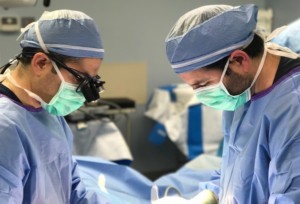
Gastrointestinal cancers or GI cancers may be in several different areas of the gastrointestinal tract including:
Gastric cancer
Colon cancer
Rectal cancer
Pancreatic cancer
Liver cancer
Dr Alfredo A. Santillan-Gomez performs GI cancer surgeries using the latest technologies and techniques to minimize a patient’s pain and required stay in the hospital. They work closely with the medical and radiation oncologists at Texas Oncology in San Antonio to perform surgery at the right time based on each patient’s health and type of cancer.
The following types of cancer surgery are performed for patients:
Subtotal and Total Gastrectomy
Removal of all or a portion of the stomach as well as the nearby lymph nodes and possibly any other nearby organs where the cancer may have spread such as the spleen, small intestine, and parts of the esophagus. The amount that is removed is dependent on the gastric cancer’s stage.
Colorectal Cancer Surgeries

Surgery is the most common treatment for colorectal cancer. Some of these surgical procedures are performed using the daVinci technology for a minimally invasive operation that uses robotics for additional precision and access that may not be possible with the human hand.
Resection - removal of the cancerous portion of the small intestine and surrounding tissue and lymph nodes.
Bypass - This is done to allow food to go around (bypass) the small intestine when a tumor is blocking the path and cannot be removed.
- Sigmoidectomy - surgery to remove all or part of the sigmoid colon - the S-shaped part of the large intestine that is just before the rectum.
- Subtotal colectomy - Removal of the colon while leaving the rectum intact.
- Right hemicolectomy - The cancer surgeon removes the right side of the colon and attaches the small intestine to the remaining portion of the colon. This is a minimally invasive surgery whenever possible to create smaller incisions, shorter hospital stays and a quicker recovery for most patients.
Cytoreductive Surgery & HIPEC
- Hyperthermic intraperitoneal chemotherapy (HIPEC) is a highly concentrated, heated chemotherapy treatment that is delivered directly to the abdomen during surgery. Unlike systemic chemotherapy delivery, which circulates throughout the body, HIPEC delivers chemotherapy directly to cancer cells in the abdomen. Used for mucinous neoplasm of the colon and appendiceal cancer.
Various types of rectal cancer surgery may be needed depending on where the cancer is located. The da Vinci robotic surgery technology is used by Dr. Alfredo A Santillan-Gomez when possible for these types of cancer.
Robotic Low Anterior Resection - The da Vinci technology is available for a minimally invasive surgery that removes all or part of the rectum and then surgically reattaches the colon to the remaining rectum or anus.
Robotic Abdominoperineal Resection (APR) - may be performed if the cancer is too close to the anus. In an APR Surgery the anal sphincter is removed using minimally invasive daVinci technology. This is the muscle that keeps the anus closed. If this is performed the patient will also typically have a colostomy that allows the body to get rid of waste in a different way.
Distal pancreatectomy - The bottom half of the pancreas is removed and sewn closed. The spleen may also need to be removed during this surgery depending on the amount of cancer and location of the tumor(s).
Whipple procedure - Also known as pancreaticoduodenectomy, the Whipple procedure involves removing the widest part of the pancreas next to the first part of the small intestine (duodenum) as well as the duodenum, a portion of the common bile duct, gallbladder, and sometimes part of the stomach. Afterward, the cancer surgeon reconnects the remaining intestine, bile duct, and pancreas.
Pancreatic enucleation - Tumors on the pancreas can be removed with a minimally invasive procedure.